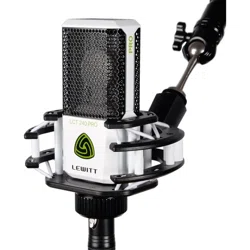Loading ...
Loading ...
Loading ...

8
// A cardioid pattern is perfect to get a very dened, articulated, and dry recording.
A dry recording gives you the freedom to add reverb (or other effects) to your
vocal track later on according to your needs. You can always add reverb, but it is
very difcult to almost impossible to reduce your room sound in post-production
without loss of signal quality.
// If the vocals sound too bright, try to sing a little bit from the side. The frequency
response changes slightly depending on the angle and you might get a more
suitable sound for your recording.
8.2. Guitar amps
// To record a guitar or bass cabinet, start with pointing your microphone towards
the speaker’s center. From there, start moving your mic outwards until you nd
a suitable sound. In the center, the speaker’s cone, the sound is the brightest.
Especially when miking speakers, slight changes in position can produce a
completely different sound. Experiment with the position (angle and distance)
of the mic, or use more than one mic to get a fuller and more unique sound.
We suggest using an additional MTP 440 DM.
8.3. Acoustic guitar
// An easy and very common way to record acoustic guitar using only one
microphone is to place it 20-30 cm away from the instrument, pointing towards
the area where the neck and body meet. If you are using two microphones, point
one towards the 12th fret, the other one points towards the soundhole.
8. Applications
A condenser microphone is a classic go-to microphone for studio work, as it can
capture every subtle nuance of the sound source, therefore delivering natural
and detailed sound.
8.1. Vocals
// Use the windscreen or a pop lter. It not only helps to avoid plosives and hisses
on your recording but also protects the condenser capsule from being exposed
to moisture.
// Dene a distance that the vocalist is supposed to keep relative to the microphone.
Depending on the voice and the style of the vocalist this distance may vary (even
during the recording). Try starting with a short distance of approximately 15 cm.
Use tape to mark a spot on the oor.
// The further away you are from the microphone, the more room sound you end
up recording besides your voice.
// The closer you are relative to your microphone, the more pronounced is your
lower frequency range. This effect is called the proximity effect, and basically
names the phenomenon of the increase of low frequency response, the closer
you get to the microphone. It helps your vocals to sound fuller and warmer, but
it is very important to nd the right balance, as too much low end in your vocals
might get in the way of the frequency range of other instruments.
Loading ...
Loading ...
Loading ...
